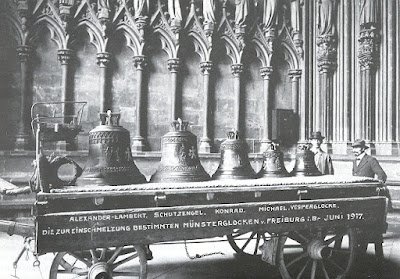
|
| Styrofoam model of the Hosanna in the bell exhibition at the Meckel Halle |
The inscription on the hem starts with O King of Glory, come with peace
|
|
| and continues When I piously sound, hasten to the people's aid, Mary. |
It rings every Thursday evening to commemorate Christ's agony on the Mount
of Olives. This goes back to a foundation letter of Johann Heinrich Föst
from 1635. Following an endowment by Baroness Maria Magdalena von
Flachsland, widow of Field Marshal
Franz von Mercy, in 1665, it also sounds every Friday at 11 a.m. to commemorate the
suffering and death at
the Battle of Freiburg in 1644. Finally, it rings on the evening of November 27 in memory of Freiburg
blackest day, the bombing in 1944.

|
| Fritz Geiges’ artist’s view |

|
|
Commemorating the Hosanna in an exhibition and announcing a free bell concert on Münsterplatz |
A few decades later, during the French occupation, even the city treasury had to be emptied to save the bell.
In 1821, the Archbishopric of Freiburg was founded, and the Minster rose from a parish church to a cathedral. A new festive bell was ordered from the Rosenlächer bell foundry in Constance in 1843. The Hosanna was allowed to stay, although its E-flat no longer fitted into the new harmony. Freiburg's voice could only appear as a soloist.
The two world wars brought Hosanna and its younger sisters into the greatest danger.

|
| Donation of bells (Glockenspende) in 1917 on a transport cart on the porch of the Minster church (©Stadtarchiv) |

|
| Bell cemetery in Hamburg harbor 1944 (©Bundesarchiv) |
In 1959, Archbishop Hermann Schäufele, then new in office, and his dyed-in-the-wool conservative vicar general Ernst Föhr ordered that new bells be cast for the cathedral because the ringing was felt to be too small for a cathedral tower.
Cathedral priest Otto Michael Schmitt and the foundation board of the
cathedral parish almost had a stroke. A "new ostentatious ringing," as Der
Spiegel wrote at the time, was inappropriate to them.
Schmitt didn't take up a collection for new bells; luckily, the Heidelberg bell founder Friedrich Wilhelm Schilling refused to melt down the Hosanna. He instead wanted to return the order for the new bells.
So the Hosanna was safe but remained a soloist because it clashed in tune with the other bells. This was later changed when 15 new bells were cast for the west tower. Those responsible in the diocese moved away from chordal towards more melodic sounds. Still, the Hosanna, now the third largest bell, continued to be rung only individually because of space limitations within the belfry.
Schmitt didn't take up a collection for new bells; luckily, the Heidelberg bell founder Friedrich Wilhelm Schilling refused to melt down the Hosanna. He instead wanted to return the order for the new bells.
So the Hosanna was safe but remained a soloist because it clashed in tune with the other bells. This was later changed when 15 new bells were cast for the west tower. Those responsible in the diocese moved away from chordal towards more melodic sounds. Still, the Hosanna, now the third largest bell, continued to be rung only individually because of space limitations within the belfry.

|
| A look into the new, extended belfry (©Axel Kilian). Note the new clappers made from stainless steel that were installed in December 2016. |
This led to the idea of a bell festival for Freiburg's
900th anniversary in 2020. Corona blew it all. On September 16 of this year, a bell concert will finally take place on Minster square.
*
No comments:
Post a Comment